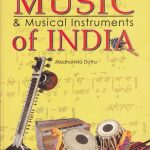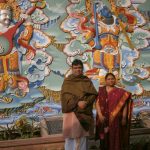ORU IRAVU IRUKKAI
We had been wanting to visit the grand Mani Mandapam of MahaPeriyava for quite sometime. And it finally happened on July 28, 2012 when we were asked to play a concert there as Anusha Nakshatram fell on that Day (Anusham is Mahaperiyava’s Birth Star). Orikkai is a very beautiful serene place and the mandapam stood as an architectural marvel. It has been constructed out of just one kind of stone (granite) like other ancient temples of the chola period, without admixture of other materials. The temple has a 100 feet vimana, the mandapam has 100 pillars and each of these pillars has been carved out of one single stone. There are elephants (again carved out of a single stone) in the front, and wheels on the side giving the impression as though the temple is a chariot being drawn by the elephants. A lifelike majestic vigraham of Mahaperiyava is housed inside a rudhraksha mandapam, and padukas of Mahaperiyava are also present. One can feel His presence perpetually in the sanctum sanctorum.
The carvings in the temple are brilliant. There are relief works depicting the Acharya Parampara, , the Pradosha Thandavam, the Navagraha on the roof with stone chains hanging; all sculpted out of a single stone.
Legend has it that Thirumazisai Alwar and the gurubhakthi of his shishya made the Lord leave Thiruvika and spend a night at this place thus giving the name oru iravu irukkai!
Here is the full story from the Manimandapam website:
The legend is a moving one. Thirumazhisai Alwar who worshipped the Lord of Thiruvekka majestically reclining on his serpentine bed, was cared for by a couple. When the son Kanikannan was born to them, he became the Alwar’s steadfast devotee. One day when Kanikannan saw a woman frail and bent with age, sweeping the temple premises offering worship to the Lord, he was moved. He stroked her hunched back in appreciation. The power of his guru surged into him and the woman regained her youth and was able to continue offering worship to the Lord with fresh vigour. The king of the period who greedily desired his youth restored to him requested Kanikannan to do so. But the youngman refused outright which enraged the king and he banished Kanikannan from his kingdom. The Alwar prepared to go with him and asked Lord Thiruvekka also to come too, as he could not live without Him. The Lord rolled up his serpentine bed and obediently followed the Alwar and Kanikannan. The three travelled some distance way from Kancheepuram on the northern bank of the Paalaar river and stayed the night there. But,with the Lord’s departure, the town was plunged in darkness and disorder. The ruler realized his mistake and rushed to the trio, seeking their forgiveness. The Lord returned to Kanchi with his devotees. The place where he stayed overnight came to be known as Oriravu irukkai, which later got shortened to Orirukkai.
The legend is a moving one. Thirumazhisai Alwar who worshipped the Lord of Thiruvekka majestically reclining on his serpentine bed, was cared for by a couple. When the son Kanikannan was born to them, he became the Alwar’s steadfast devotee. One day when Kanikannan saw a woman frail and bent with age, sweeping the temple premises offering worship to the Lord, he was moved. He stroked her hunched back in appreciation. The power of his guru surged into him and the woman regained her youth and was able to continue offering worship to the Lord with fresh vigour. The king of the period who greedily desired his youth restored to him requested Kanikannan to do so. But the youngman refused outright which enraged the king and he banished Kanikannan from his kingdom. The Alwar prepared to go with him and asked Lord Thiruvekka also to come too, as he could not live without Him. The Lord rolled up his serpentine bed and obediently followed the Alwar and Kanikannan. The three travelled some distance way from Kancheepuram on the northern bank of the Paalaar river and stayed the night there. But,with the Lord’s departure, the town was plunged in darkness and disorder. The ruler realized his mistake and rushed to the trio, seeking their forgiveness. The Lord returned to Kanchi with his devotees. The place where he stayed overnight came to be known as Oriravu irukkai, which later got shortened to Orirukkai.
Now about our experience there….it was the calmest place you could ever get to play the veena, with Umayalpuram Mali expertly accompanying. The main piece we played that day was Sri Subramayaya Namaste, the majestic Dikshitar composition in Khamboji about which Paramacharya has given a vast commentary. We chose not to prefix or suffix this magnum opus kriti with manodharma aspects. Just the song, as a respectful tribute to the Nadamadum Deivam and the Great Saint Muthuswamy Dikshitar. We finished our concert and were given prasadam of thayir sadam. The humble curd rice has never tasted as good as this for as long as one could remember. With our souls and stomachs satiated, we were just preparing to leave, when we heard someone singing inside the sanctum sanctorum. Jeyaraaj came up with a brilliant idea. He requested the priest permission to allow me to sing a kriti that yours truly had recently composed on Muthuswamy Dikshitar but was still thinking about how when and where to present it the first time! It was a huge blessing to present the composition sitting before the idol of the Paramacharya.
Given below is the sahityam of this humble creation (lyrics ratified for grammatical correctness by our own Asthana Sanskrit Scholar Rajani Arjun!!):
Kriti: Mudduswaaminam guruvaram
Ragam: Hamsanandi
Thalam: Misra Jati Triputa
P: mudduswaaminam guruvaram namaamyaham
uttara dakshina sangeetha samanvaya swarupam
A: itihaasa puraanaadi upanishad saaram
raagalakshana saram paramadvaita saaram
madhyama kala:
vainika gayaka shreshtha naadaanubhava saccidaananda cidaananda aanandanubhava
C: samskrita bhasha priyam digvijaya priyam
nutana paashchaatya swarasaahitya pradam guruguhapriyam
nutana paashchaatya swarasaahitya pradam guruguhapriyam
madhyama kala:
sri ganesha narayana panchabhoota kamalambika abhayambika neelotpalambika sharanam
hariharaputra ramanjaneya ramaa vaani navagraha dwisaptadi raga devata sharanam
sri ganesha narayana panchabhoota kamalambika abhayambika neelotpalambika sharanam
hariharaputra ramanjaneya ramaa vaani navagraha dwisaptadi raga devata sharanam
All in all, July 28, 2012 was a memorable day as it was spiritually very satisfying to play a veena concert in the Mahaperiyava Shatabdi Manimandapam, and also the opportunity to do an “arangetram” of one’s own composition in front of the Paramacharya’s idol. Felt truly blessed……
(Pic sourced from http://indiatempletour.blogspot.in)
Recent Posts






